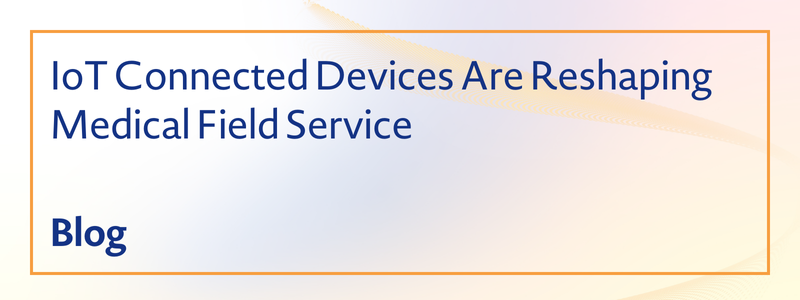IoT Connected Devices Are Reshaping Medical Field Service


(Source: Anna Shvets on Pexels)
Field service organizations that maintain medical devices in clinical settings faced a tumultuous year in 2020. Restrictions due to social distancing guidelines added new challenges to the process of maintaining the uptime of medical devices, deploying technicians, and pursuing future technology initiatives.
But there are indications that medical device manufacturers are progressing in their digital transformations, pursuing new service models that incorporate IoT-connected devices, remote service, and self-service. This evolution in medical field service has arrived at an important time.
According to an article by LexisNexis Risk Solutions, healthcare providers need operable technology at their disposal more than ever: "Healthcare technology goals, such as accurate patient information, linked patient records, interoperability and cybersecurity continue to be at the forefront. The pandemic has only amplified the need for these technologies to become realities in healthcare."
In 2019, the Field Service Medical conference series and WBR Insights reported that there would be over 20 billion IoT devices installed by 2020, mostly in consumer products. But there is evidence that IoT connectivity is increasing among medical device manufacturers. Here's what the new ecosystem of connected medical devices means for healthcare providers and the future of medical field service.
The Internet of Medical Things (IoMT)
Medical device manufacturers and their field service departments have already made significant strides in developing new models of field service that bypass these risks and can even result in better outcomes for end-users and clients. Many organizations are now deploying Internet of Things (IoT) connected medical devices and retrofitting existing assets with connected technologies, allowing them to gather data on deployed assets as they operate in the field.
A recent report by Deloitte says, "Major advances in wireless technology, miniaturization and computing power are driving innovation in MedTech, leading to the development of an increasing number of connected medical devices that are able to generate, collect, and analyze and transmit data. The data, along with the devices themselves, are creating the Internet of Medical Things (IoMT)—a connected infrastructure of medical devices, software applications and health systems."
As a result of the IoMT, many medical device field service organizations can engage in proactive and predictive maintenance. They are also improving first-time fix rates thanks to their wide breadth of knowledge about the status of deployed assets.
Remote Monitoring and Remote Repair
Two of the most significant technologies for medical field service organizations are remote monitoring and repair technologies. These solutions enable the organization to collect real-time data on devices in the field and potentially initiate repairs without the cost of sending a technician to the field, and they are only possible thanks to IoT connectivity.
Remote monitoring technology is perhaps the cornerstone of the IoMT. In this model, software solutions can draw data from connected devices in the field. Once that data is structured, it can be leveraged in a central system, enabling the organization to draw insights about the status of deployed assets and make predictions about when service will be required.
This enables medical device manufacturers to ensure clients receive optimal uptime from their devices. Field service teams can also use this data to automate service before devices break down, preventing the necessity of an on-site visit or a product replacement.
It's through this strategy that medical device manufacturers can provide clients with contract-based service agreements. These types of agreements are driving the adoption of integrated service packages alongside product sales.
Meanwhile, remote repair solutions can also leverage this data to automatically schedule appointments for remote experts to assist end-users and clients with repairs. This can be accomplished using augmented reality and video conferencing features, which are both available on consumer technology platforms.
AI and Machine Learning
Finally, many medical device manufacturers are interested in what technologies like artificial intelligence (AI) and machine learning (ML) could mean for the customer experience.
Using IoT data, AI can create operational profiles for deployed assets, using them as a baseline to detect performance changes across the organization's customer base. Once the operability of a device diminishes, the AI can schedule maintenance services, alert stakeholders, and help the end-user avoid interruptions in service.
ML technology can enhance the insights generated by AI in this regard by learning from past service operations. In the future, AI will likely be making service decisions on its own, serving as a lynchpin for the entire medical device field service organization.
Prepare for the Next Phase of IoT and Connected Devices in Medical Field Service
These are just a few of the advances medical device manufacturers can expect thanks to connected medical devices and the IoMT. To learn more about how these technologies could impact your business, don't miss the next event from the Field Service Medical conference series.
Reserve your spot at the next event today.